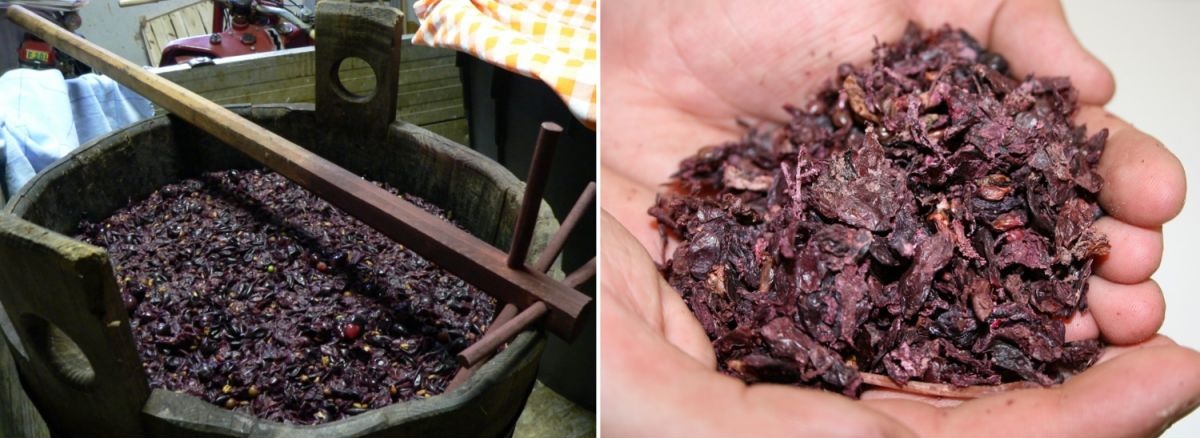Term (Old High German trestir = mixed with cloudy sediment) for the residue from grape pressing or residue after mash fermentation and also for the spirit distilled from it (marc spirit).
Press residue
Term for the pulpy mass of grape skins, pulp, seeds and, if no destemming has taken place beforehand, also stems after pressing. Other names are Bälisch (Mosel), Lauer, Leier, Lor(c)ke, Lur(c)ke, Trebern, Tröber and Trasch/Träsch (Switzerland). Sometimes a distinction is made: Trester = press residue (white wine), Trebern = fermentation residue (red wine). The components that float to the top during mash fermentation are called marc cap. This is brought into intensive contact with the must/wine either mechanically or manually during fermentation (see under Pigeage = punching down). The picture on the left shows the open mash fermentation of a red wine, the picture on the right a red wine marc.

Brandy (spirit)
Around 25 kilograms of moist marc are produced from 100 litres of mash. It consists of around 75% skins and 25% pips. Pomace is also often used as organic fertiliser in vineyards and the food colouring oenocyanin is obtained from red wine pomace. The grape seeds from the marc are occasionally used to produce grape seed oil. In most wine-growing countries, a spirit is distilled from the marc. Depending on whether the pomace contains only sugar, alcohol and unfermented sugar or only more alcohol, the pomace is labelled as natural, semi-fermented or fully fermented. As a rule, naturally pure marc is made from white grape varieties, semi-fermented marc is made from a mixture of white and red grapes, and fully fermented marc is made from red grapes. When making white wine, the press residue still contains a large amount of unfermented sugar. The marc must therefore first be fermented before distillation.

The residue from red wine production also contains dead yeast cells and alcohol. The pomace can therefore be distilled directly in special distillation equipment, which is mandatory for Italian grappa, for example. However, there are also products where water is added to the marc, the fermented base wine is separated from the residues and then distilled. The quality of the marc also depends on the liquid it still contains. Only lightly pressed pomace without too much tannin generally produces better qualities.
In Germany and Austria, the spirit is called Trester (like the residue itself) or Tresterbrand (but Trebern or Trebernbrand is not authorised). It is bottled after distillation or matured in tanks and/or wooden barrels. It is also flavoured with herbs, spices and fruit. Pomace wine, which used to be produced mainly for personal consumption, is hardly produced any more.
Designation in other countries
Pomace brandies in other countries are called Bagaceira (Portugal), Grappa (Italy), Marc (France), Orujo (Spain), Törkölypálinka (Hungary), Tsipouro or Tsikoudia (Greece) and Zivania (Cyprus).
Further information
For the production of alcoholic beverages, see Champagne (sparkling wines), Distillation (distillates), Speciality wines, Spirits (types), Winemaking (wines and wine types) and Wine law (wine law issues).
Vat with marc: CC BY-SA 3.0, Ligilo
Handful of marc: By Adrian J. Hunter - Own work, CC BY-SA 3.0, Link
Voices of our members

Using the encyclopaedia is not only time-saving, but also extremely convenient. What's more, the information is always up to date.
Markus J. Eser
Weinakademiker und Herausgeber „Der Weinkalender“